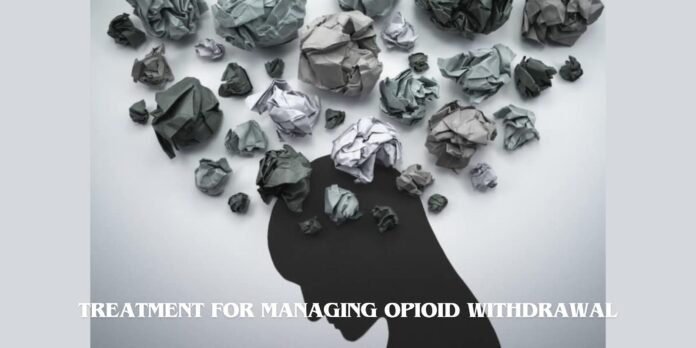The process of withdrawing from opioids involves a negative emotional state that reinforces the continuation of seeking drugs and relapsing. Therefore, comprehending the neurobiological mechanisms associated with opioid withdrawal is crucial for scientists and healthcare professionals striving to innovate new treatments and therapies. Treatment for opioid addiction varies depending on individual needs, but the primary objective is to cease drug use. Additionally, treatment aims to facilitate recovery and prevent future drug use.
What is Opioid withdrawal
Opioids encompass a collection of potent medications that your doctor might prescribe to assist in pain management. The phrase “opioid withdrawal” encompasses a spectrum of physical and mental symptoms individuals undergo when they reduce or discontinue their use of opioids following prolonged exposure. These symptoms can vary in severity from little pain to severe anguish, contingent on variables like the length and volume of opioid usage, as well as tolerance and metabolic variations among individuals.
Factors contributing to opioid withdrawal
- Using opioids sporadically reduces the likelihood of experiencing withdrawal symptoms.
- Prolonged high intake (beyond six months) tends to result in more severe withdrawal experiences.
- Withdrawal onset is faster and duration shorter with short-acting opioids and injected slow-release morphine.
- Conversely, longer-acting opioids like methadone and oral slow-release formulations have slower onset but longer-lasting withdrawal effects.
Extended use of opioid medication leads to a tolerance build-up in your body, requiring higher doses for the same effect. This escalates the risk of accidental overdose, posing significant danger.
Continued consumption alters nerve receptor functions in the brain, making them reliant on the drug for operation. Experiencing physical sickness upon cessation indicates a physical dependency on the substance. Withdrawal symptoms manifest as the body’s response to the absence of the drug.
Experiencing opioid withdrawal symptoms is an uncomfortable result of suddenly stopping or reducing the dose of opioid medications. Similarly, they can occur if you take another medication that blocks opioids from functioning.
These symptoms can make you feel unwell, underscoring the importance of planning how to taper off your medication.
Withdrawal symptoms are consistent across all opioids:
- Disrupted sleep
- Feelings of anxiety or irritability
- Watery eyes, runny nose, and sneezing
- Hot and cold flashes
- Cravings for opioids
- Nausea, vomiting, and diarrhea
- Tremors
The concept of drug tolerance arises as the body becomes accustomed to the effects of a drug over time. Consequently, higher doses of the drug may be required to achieve the same effects.
Living with opioid addiction requires acknowledgment of the issue as the first step toward recovery. Seeking help is crucial for individuals grappling with addiction. Recognizing addiction as a treatable disease is imperative, as it fosters a readiness to enact changes.
To combat addiction, individuals are encouraged to:
- Commit to cessation: Assume control of behavior and commit to breaking the cycle of opioid use.
- Seek assistance from a healthcare provider: Physicians can offer invaluable support, even if the drug in question was initially prescribed by them. Medical professionals may prescribe medications to alleviate cravings for the addictive substance. Engaging in discussions with a doctor or counselor regarding drug use and associated problems can prove beneficial.
- Seek support from relevant organizations: Numerous organizations are dedicated to aiding individuals with addictions. These organizations are invested in their client’s success and provide the necessary tools and resources for quitting and recovery. Seeking support from friends and family members can also be instrumental in the recovery process.
Techniques for Handling the Withdrawal of Opioids
Medication-Assisted Treatment (MAT)
MAT is a way to treat opioid withdrawal symptoms and promote long-term recovery by using drugs like methadone, buprenorphine, and naltrexone. By lowering cravings and stabilizing patients during the withdrawal stage, these drugs free up patients’ attention for other treatment modalities including counselling and therapy.
Symptom Management
Relieving symptoms might help lessen the discomfort that comes with tapering off opioids. Temporary relief from physical symptoms may be obtained using over-the-counter medications, including pain relievers, anti-nausea pills, and diarrheal medicines. But before taking any medicine, it’s imperative to speak with a doctor because some medications might worsen withdrawal symptoms or interact with opioids.
Psychological help
Since people may experience severe emotional discomfort during the withdrawal process, psychological help is essential. During this difficult period, therapy, counseling, and support groups can give people coping mechanisms, emotional support, and a feeling of community. It has been demonstrated that mindfulness-based therapies and cognitive-behavioral therapy (CBT) are especially beneficial in treating anxiety and despair associated with withdrawal.
Nutritional Support
As people may have gastrointestinal distress and appetite loss during opioid withdrawal, proper nutrition is crucial. Consuming a diet high in fruits, vegetables, lean meats, and whole grains can help boost immunity, support the body’s natural defenses, and improve general health. Furthermore, it’s critical to maintain proper hydration to avoid electrolyte imbalances and dehydration.
Gradual Tapering
Under the guidance of a medical practitioner, a gradual reduction in opioid dosage is carried out over time. By allowing the body to acclimate gradually to decreased opioid levels, tapering helps to minimize the intensity of withdrawal symptoms and lowers the chance of recurrence. For those who are physically dependent on opioids but are not yet ready for detoxification or medication-assisted treatment, this strategy is frequently advised.
Final Thoughts
A difficult but necessary first step in conquering opioid addiction is opioid withdrawal. Through comprehension of the signs and symptoms of withdrawal and the application of practical coping strategies, people can get through this challenging stage with courage, support, and optimism. There are numerous services available to aid people in overcoming opioid withdrawal and beginning recovery, whether it be through medication-assisted treatment, psychological support, or lifestyle modifications. on a path toward long-term sobriety and wellness.


